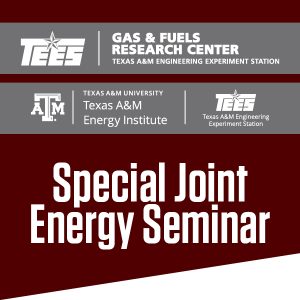Polyolefins Technologies – Emerging Trends, Challenges & Future Directions

The Texas A&M Energy Institute and the TEES Gas & Fuels Research Center are co-hosting a Special Joint Energy Seminar featuring Jayant D Divey, a Polyolefins Technology Consultant. This event will be held on Friday, April 23, 2021, from 9:00 – 10:00 a.m. on Zoom. The topic will be “Polyolefins Technologies – Emerging Trends, Challenges & Future Directions.”
Biography
Jayant D. Divey works as a Polyolefins Technology Consultant supporting technology evaluation and selection, process design, and troubleshooting for new grassroots as well as operating petrochemicals plants. Prior to that, he retired as Senior Vice President from Reliance Industries Limited, Mumbai, India where he was responsible for polyolefins technologies. He has four decades of extensive experience in practically all HDPE, LLDPE, LDPE, and PP technologies. He also worked as a technology manager in FCC light olefins, handling C2, C3, C4, and C5 chemicals. His areas of interest and expertise range from polyolefins catalysts and polymerization reaction systems to products. He has led many projects from concept to commissioning including design basis to engineering. He has several publications to his credit.
He holds a BS degree from the Laxminarayan Institute of Technology Nagpur University, and an MS degree from the Indian Institute Technology Bombay, both in Chemical Engineering.
Abstract
Polyethylene (PE) and Polypropylene (PP) plants are the popular downstream derivatives of ethylene crackers or petrochemical fluidized catalytic cracking units (petro-FCC). Refineries have been diversifying into petrochemicals to improve upon the gross refinery margin (GRM) and flexibility in product mix. This has led to the evolution of the configuration of integrated refinery and petrochemicals complexes.
Building such large complexes requires high CAPEX, thus justifying a rise in the demand to optimize cost economics. Consequently, ethylene cracker plants with capacities exceeding 1 MMtpy of ethylene have become the industry norm. Ethylene plant capacities have soared close to 2 MMtpy, which was unthinkable two decades ago.
As the ever-growing thermoplastic, PE has been riding the wave and sharing the bulk of the ethylene pie. It is not uncommon to see one, two, or even three PE plants in the configuration. Similarly, at least one PP plant usually always fits in the configuration. The integration of petro-FCC with a PP plant has become the common practice in many refineries that do not want to venture into other petrochemicals.
Similarly, the combination of propane dehydrogenation (PDH) and PP plants has also risen in the last two decades. This has increased the trend of one or two large PP plants with the ever-expanding PP market. With the inclusion of multiple PE / PP plants to match the olefins balance, the single-line capacities of PE / PP plants have risen to 450,000 tpy–550,000 tpy. Until about 2010, PE / PP plant capacities of 300,000 –400,000 tpy were considered standard for a large plant. However, PE / PP technology licensors have kept up the pace by offering capacities in the range of 450,000 tpy–650,000 tpy, depending on the product mix. This presentation will briefly explore the determining factors for different premium technologies that might limit single-line capacities, as well as potential challenges for future capacity increases.
